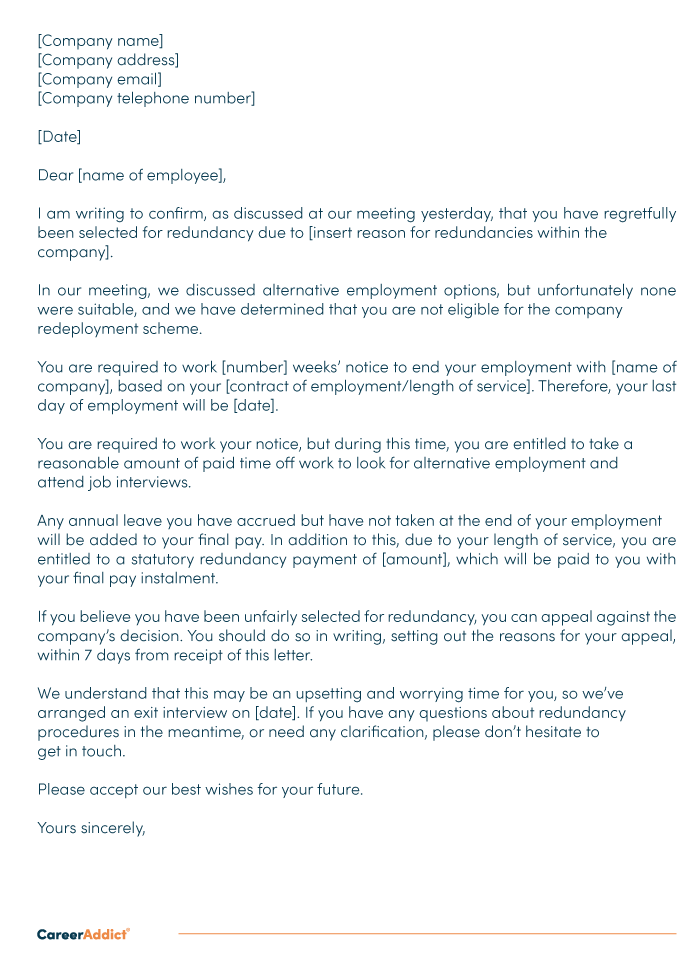What Happens to Redundancy If Company Goes Bust? A Guide to Your Rights
What Happens to Redundancy If Company Goes Bust? A Guide to Your Rights
Blog Article
Exploring the Interplay Between Company Redundancy and Business Flexibility for Future Development
In the vibrant landscape these days's company globe, the detailed connection in between company redundancy and organizational flexibility arises as a vital aspect for continual growth and success. Companies frequently deal with the challenge of striking a delicate balance between keeping a degree of redundancy to alleviate threats and cultivating flexibility to respond swiftly to the ever-evolving market demands. This delicate interaction holds the vital to not only making it through in rough times yet also thriving despite unpredictability. As we explore the diverse measurements of this interaction, interesting insights into how organizations browse these complexities to lead the way for future growth wait for.
Importance of Firm Redundancy
Firm redundancy is a crucial component that enhances organizational resilience and reduces functional risks. By including redundancy measures within the organizational framework, firms can much better endure unexpected disturbances and fluctuations in the company setting. Redundancy functions as a critical buffer, enabling companies to adapt and respond properly to unforeseen difficulties without jeopardizing necessary operations.
One secret aspect of the importance of firm redundancy is its duty in ensuring connection throughout times of situation. When confronted with unexpected adjustments or emergencies, repetitive systems, resources, or employees can step in to maintain essential features and avoid extensive disturbances. This connection not only safeguards the firm's credibility and customer count on yet also decreases monetary losses and functional downtime.

Methods for Business Flexibility

One more essential technique is spending in modern technology and framework that can sustain adaptability and scalability. Implementing electronic tools, automation, and information analytics can improve procedures, improve performance, and provide beneficial understandings for notified decision-making. Additionally, creating adaptable business structures that enable for fast modifications to market dynamics and client requirements is crucial for staying affordable in a quickly developing atmosphere. By proactively determining prospective disruptions and chances, companies can proactively flourish and adapt in an ever-changing business landscape.
Balancing Redundancy and Flexibility
Attaining an unified stability between operational redundancy and organizational versatility is paramount in navigating the intricacies of a dynamic company atmosphere. Redundancy within a company supplies a security net, making sure connection and stability in procedures. Nonetheless, an extra of redundancy can result in ineffectiveness and prevent flexibility to altering market problems. why not try here On the other hand, business versatility permits companies to react promptly to exterior interruptions and seize new chances. Striking the appropriate balance between redundancy and flexibility is a delicate procedure that calls for a deep understanding of the company's objectives, sector characteristics, and threat resistance.
To achieve this balance, business require to carry out regular analyses of their operations to determine areas where redundancy is necessary for threat mitigation and where adaptability can drive advancement and development. Implementing versatile frameworks, fostering a society of constant discovering and renovation, and encouraging open communication throughout all degrees of the organization are essential approaches to integrate redundancy and versatility effectively. By straightening these 2 important components, companies can position themselves for lasting development and success in an ever-changing business landscape.
Study on Adaptation Success
In analyzing circumstances of effective business adaptation, it ends up being noticeable that the interplay in between functional redundancy and flexibility is a defining aspect in forming resistant organizations. One compelling study is that of Netflix. Initially a DVD rental service, Netflix showed impressive adaptability by transitioning right into a streaming system when digitalization disrupted the sector. By strategically investing in technology and content development, Netflix not only survived however prospered in a swiftly evolving market. An additional standout instance is Amazon. Beginning as an online book shop, Amazon continuously adjusted its company design, increasing into diverse fields such as cloud computer and expert system. This flexibility enabled Amazon to remain ahead of rivals and fulfill transforming customer needs. Lastly, check out this site Adobe offers a significant image of successful adjustment. The company shifted from selling software program licenses to a subscription-based version, making certain persisting income streams and enhanced client engagement. These study underscore the importance of functional redundancy combined with business adaptability in cultivating lasting growth and competition.
Building Resilience for Future Growth
Building strength for future growth calls for a calculated positioning of functional processes with market dynamics and emerging trends. Companies need to adjust to altering atmospheres by fostering a society of flexibility, technology, and continuous enhancement.
In addition, fostering solid relationships with stakeholders, such as customers, staff members, providers, and the community, is essential for maintaining and weathering unpredictabilities trust and assistance throughout rough times. Effective interaction and openness play an essential role in structure strength, as they help assist in and align assumptions cooperation in navigating unpredictabilities.
In addition, companies need to prioritize knowing and development efforts to upskill workers and equip them with the necessary devices to adjust to transforming scenarios. By purchasing their labor force, companies can boost their flexibility and dexterity, eventually reinforcing their strength for lasting future growth.
Final Thought

In the vibrant landscape of today's business globe, the complex partnership in between business redundancy and organizational versatility arises as an important element for continual growth and success. Business often deal with the challenge of striking a fragile balance in between keeping a degree of redundancy to reduce risks and promoting adaptability to respond promptly to the ever-evolving market demands.To achieve this equilibrium, business need to conduct normal assessments of their procedures to determine areas where redundancy is required for threat mitigation and where flexibility can drive technology and growth.In verdict, the interplay in between company redundancy and business navigate to this website adaptability is important for future development. Structure strength via a combination of redundancy and versatility will certainly ensure that business are prepared for the difficulties of the future.
Report this page